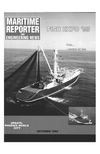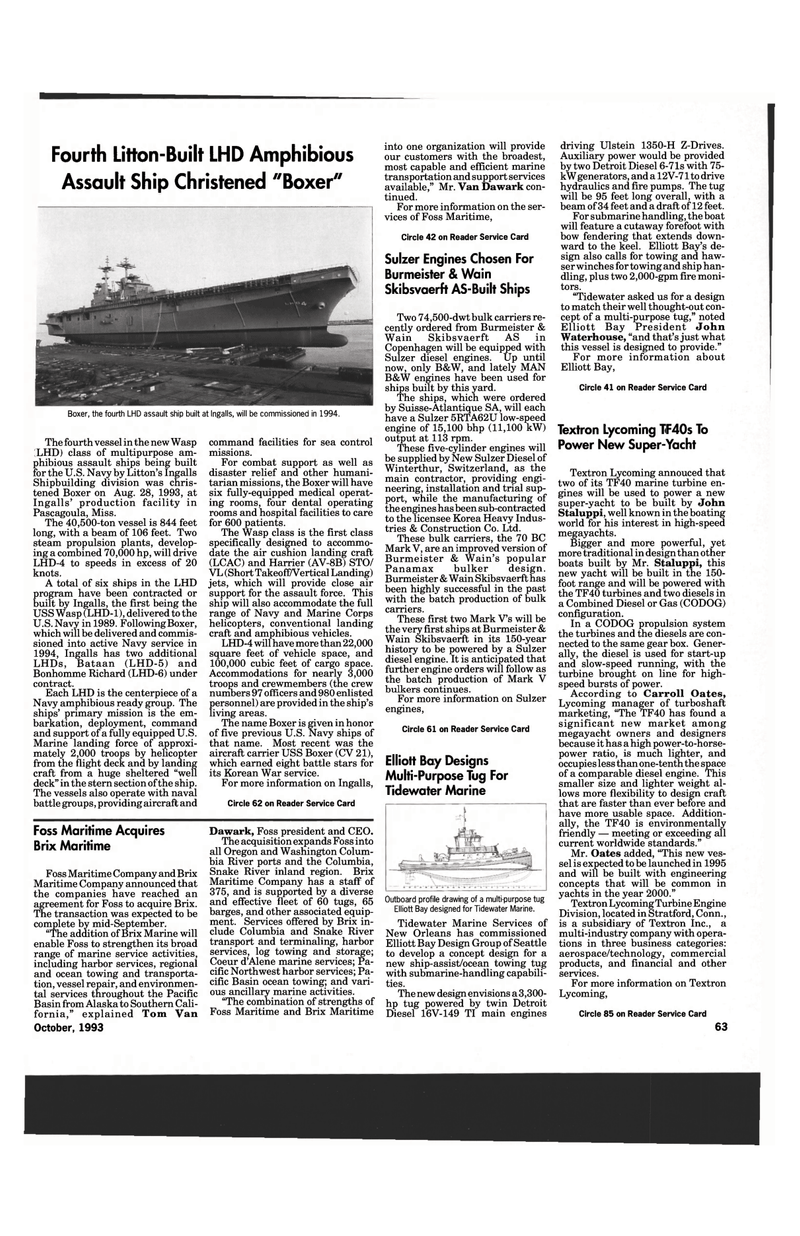
Page 61: of Maritime Reporter Magazine (October 1993)
Read this page in Pdf, Flash or Html5 edition of October 1993 Maritime Reporter Magazine
Fourth Litton-Built LHD Amphibious
Assault Ship Christened "Boxer"
Boxer, the fourth LHD assault ship built at Ingalls, will be commissioned in 1994.
The fourth vessel in the new Wasp
LHD) class of multipurpose am- phibious assault ships being built for the U.S. Navy by Litton's Ingalls
Shipbuilding division was chris- tened Boxer on Aug. 28, 1993, at
Ingalls' production facility in
Pascagoula, Miss.
The 40,500-ton vessel is 844 feet long, with a beam of 106 feet. Two steam propulsion plants, develop- ing a combined 70,000 hp, will drive
LHD-4 to speeds in excess of 20 knots.
A total of six ships in the LHD program have been contracted or built by Ingalls, the first being the
USS Wasp(LHD-l), delivered to the
U.S. Navy in 1989. Following Boxer, which will be delivered and commis- sioned into active Navy service in 1994, Ingalls has two additional
LHDs, Bataan (LHD-5) and
Bonhomme Richard (LHD-6) under contract.
Each LHD is the centerpiece of a
Navy amphibious ready group. The ships' primary mission is the em- barkation, deployment, command and support of a fully equipped U.S.
Marine landing force of approxi- mately 2,000 troops by helicopter from the flight deck and by landing craft from a huge sheltered "well deck" in the stern section of the ship.
The vessels also operate with naval battle groups, providing aircraft and
Foss Maritime Acquires
Brix Maritime
Foss Maritime Company and Brix
Maritime Company announced that the companies have reached an agreement for Foss to acquire Brix.
The transaction was expected to be complete by mid-September. "The addition of Brix Marine will enable Foss to strengthen its broad range of marine service activities, including harbor services, regional and ocean towing and transporta- tion, vessel repair, and environmen- tal services throughout the Pacific
Basin from Alaska to Southern Cali- fornia," explained Tom Van
October, 1993 command facilities for sea control missions.
For combat support as well as disaster relief and other humani- tarian missions, the Boxer will have six fully-equipped medical operat- ing rooms, four dental operating rooms and hospital facilities to care for 600 patients.
The Wasp class is the first class specifically designed to accommo- date the air cushion landing craft (LCAC) and Harrier (AV-8B) STO/
VL (Short Takeoff/Vertical Landing) jets, which will provide close air support for the assault force. This ship will also accommodate the full range of Navy and Marine Corps helicopters, conventional landing craft and amphibious vehicles.
LHD-4 will have more than 22,000 square feet of vehicle space, and 100,000 cubic feet of cargo space.
Accommodations for nearly 3,000 troops and crewmembers (the crew numbers 97 officers and 980 enlisted personnel) are provided in the ship's living areas.
The name Boxer is given in honor of five previous U.S. Navy ships of that name. Most recent was the aircraft carrier USS Boxer (CV 21), which earned eight battle stars for its Korean War service.
For more information on Ingalls,
Circle 62 on Reader Service Card
Dawark, Foss president and CEO.
The acquisition expands Foss into all Oregon and Washington Colum- bia River ports and the Columbia,
Snake River inland region. Brix
Maritime Company has a staff of 375, and is supported by a diverse and effective fleet of 60 tugs, 65 barges, and other associated equip- ment. Services offered by Brix in- clude Columbia and Snake River transport and terminaling, harbor services, log towing and storage;
Coeur d'Alene marine services; Pa- cific Northwest harbor services; Pa- cific Basin ocean towing; and vari- ous ancillary marine activities. "The combination of strengths of
Foss Maritime and Brix Maritime into one organization will provide our customers with the broadest, most capable and efficient marine transportation and support services available," Mr. Van Dawark con- tinued.
For more information on the ser- vices of Foss Maritime,
Circle 42 on Reader Service Card
Sulzer Engines Chosen For
Burmeister & Wain
Skibsvaerft AS-Built Ships
Two 74,500-dwt bulk carriers re- cently ordered from Burmeister &
Wain Skibsvaerft AS in
Copenhagen will be equipped with
Sulzer diesel engines. Up until now, only B&W, and lately MAN
B&W engines have been used for ships built by this yard.
The ships, which were ordered by Suisse-Atlantique SA, will each have a Sulzer 5RTA62U low-speed engine of 15,100 bhp (11,100 kW) output at 113 rpm.
These five-cylinder engines will be supplied by New Sulzer Diesel of
Winterthur, Switzerland, as the main contractor, providing engi- neering, installation and trial sup- port, while the manufacturing of the engines has been sub-contracted to the licensee Korea Heavy Indus- tries & Construction Co. Ltd.
These bulk carriers, the 70 BC
Mark V, are an improved version of
Burmeister & Wain's popular
Panamax bulker design.
Burmeister & Wain Skibsvaerft has been highly successful in the past with the batch production of bulk carriers.
These first two Mark Vs will be the very first ships at Burmeister &
Wain Skibsvaerft in its 150-year history to be powered by a Sulzer diesel engine. It is anticipated that further engine orders will follow as the batch production of Mark V bulkers continues.
For more information on Sulzer engines,
Circle 61 on Reader Service Card
Elliott Bay Designs
Multi-Purpose Tug For
Tidewater Marine
Outboard profile drawing of a multi-purpose tug
Elliott Bay designed for Tidewater Marine.
Tidewater Marine Services of
New Orleans has commissioned
Elliott Bay Design Group of Seattle to develop a concept design for a new ship-assist/ocean towing tug with submarine-handling capabili- ties.
The new design envisions a 3,300- hp tug powered by twin Detroit
Diesel 16V-149 TI main engines driving Ulstein 1350-H Z-Drives.
Auxiliary power would be provided by two Detroit Diesel 6-7 Is with 75- kW generators, and a 12V-71 to drive hydraulics and fire pumps. The tug will be 95 feet long overall, with a beam of 34 feet and a draft of 12 feet.
For submarine handling, the boat will feature a cutaway forefoot with bow fendering that extends down- ward to the keel. Elliott Bay's de- sign also calls for towing and haw- ser winches for towing and ship han- dling, plus two 2,000-gpm fire moni- tors. "Tidewater asked us for a design to match their well thought-out con- cept of a multi-purpose tug," noted
Elliott Bay President John
Waterhouse, "and that's just what this vessel is designed to provide."
For more information about
Elliott Bay,
Circle 41 on Reader Service Card
Textron Lycoming TF40s To
Power New Super-Yacht
Textron Lycoming annouced that two of its TF40 marine turbine en- gines will be used to power a new super-yacht to be built by John
Staluppi, well known in the boating world for his interest in high-speed megayachts.
Bigger and more powerful, yet more traditional in design than other boats built by Mr. Staluppi, this new yacht will be built in the 150- foot range and will be powered with the TF40 turbines and two diesels in a Combined Diesel or Gas (CODOG) configuration.
In a CODOG propulsion system the turbines and the diesels are con- nected to the same gear box. Gener- ally, the diesel is used for start-up and slow-speed running, with the turbine brought on line for high- speed bursts of power.
According to Carroll Oates,
Lycoming manager of turboshaft marketing, "The TF40 has found a significant new market among megayacht owners and designers because it has a high power-to-horse- power ratio, is much lighter, and occupies less than one-tenth the space of a comparable diesel engine. This smaller size and lighter weight al- lows more flexibility to design craft that are faster than ever before and have more usable space. Addition- ally, the TF40 is environmentally friendly — meeting or exceeding all current worldwide standards."
Mr. Oates added, "This new ves- sel is expected to be launched in 1995 and will be built with engineering concepts that will be common in yachts in the year 2000."
Textron Lycoming Turbine Engine
Division, located in Stratford, Conn., is a subsidiary of Textron Inc., a multi-industry company with opera- tions in three business categories: aerospace/technology, commercial products, and financial and other services.
For more information on Textron
Lycoming,
Circle 85 on Reader Service Card 63

 60
60

 62
62
